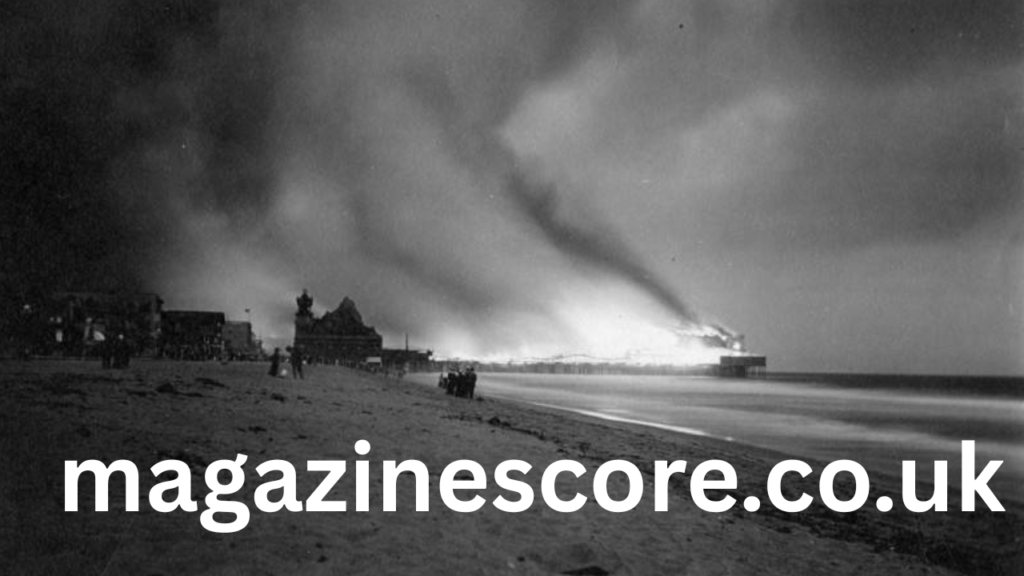The Santa Monica Pier is not just a tourist destination—it’s a cultural landmark, a piece of American nostalgia, and a living snapshot of Southern California’s coastal lifestyle. Its colorful lights, historic carousel, amusement rides, and oceanfront dining make it one of the most visited attractions on the West Coast.
But in early 2025, the iconic pier faced an unexpected threat—not from a blaze directly beneath its wooden planks, but from a firestorm raging nearby in Pacific Palisades. The Santa Monica Pier fire headlines sparked global concern. While the pier itself wasn’t consumed by flames, the environmental and public health impact was tangible and widespread, making the event a defining moment for the region.
This article explores everything from the origin of the wildfire to the pier’s involvement, environmental consequences, local responses, and what this means for coastal cities grappling with climate-fueled disasters.
Understanding the “Santa Monica Pier Fire” Misconception
The phrase “Santa Monica Pier fire” gained traction as footage of the pier engulfed in thick smoke circulated on social media and news outlets. Many assumed the pier had caught fire. However, authorities clarified that while ash and debris blanketed the pier, no flames reached it.
The misnomer persisted for good reason. Emergency alerts warned Santa Monica residents of poor air quality, falling embers, and evacuation advisories. The pier was temporarily closed due to health and safety concerns.
This highlights a growing challenge: how wildfires impact urban coastal infrastructure, even without direct fire damage.
Toxic Skies Over the Pacific
As plumes of smoke drifted toward Santa Monica, air quality levels plummeted to hazardous. The famous ocean breeze, once symbolic of fresh coastal air, carried a cocktail of particulate matter, ash, and chemical pollutants.
Environmental groups, including Heal the Bay, conducted air and ocean water testing. Their findings included:
- Elevated levels of PM2.5 and PM10 (tiny particles harmful to lungs)
- Detection of polycyclic aromatic hydrocarbons (PAHs) from burnt materials
- Traces of heavy metals such as beryllium, arsenic, and lead
These airborne toxins settled into the ocean, contaminating beachfront waters and marine ecosystems.
Contaminated Waters and Surfer Warnings
Santa Monica’s beaches, especially around the pier, are a haven for surfers, swimmers, and tourists. After the wildfire, environmental scientists found that rain had washed toxic debris and ash runoff into the storm drains, leading directly to the ocean.
Surfers reported symptoms like:
- Skin rashes
- Respiratory irritation
- Eye burning
- Nausea after exposure
Although city officials reassured the public that contaminant levels were “within regulatory limits,” surfers and local residents remained wary.
Damage Beyond the Flames: Economic Fallout
Tourism Takes a Hit
The Santa Monica Pier generates millions annually in revenue from tourism. But after the wildfire, visitor numbers dropped significantly due to:
- Hazardous air quality
- Beach closures
- Social media rumors of fire damage
- Travel warnings issued by health departments
Businesses on and around the pier—restaurants, souvenir shops, amusement vendors—saw immediate losses. Many were forced to close temporarily.
Insurance and Cleanup Costs
Even though the pier wasn’t physically burned, insurance claims were filed for:
- Smoke damage
- Air filtration system replacements
- Lost business income
Cleanup involved everything from pressure washing the santa monica pier fire to testing water and food for contamination. The environmental toll, paired with financial strain, created a ripple effect across Santa Monica’s economy.
Previous article; How Audio Transcription Services Improve Accessibility in Media
Wildfires and Coastal Climate Risks: A Dangerous Intersection
Why Santa Monica Is Increasingly Vulnerable
Historically, coastal cities like Santa Monica haven’t been at the center of wildfire threats. But as climate change intensifies, the wildland-urban interface expands. Santa Monica sits adjacent to the Santa Monica Mountains, a fire-prone region growing more volatile every year.
Factors increasing vulnerability include:
- Longer drought seasons
- Stronger winds
- Urban sprawl into fire zones
- Aging infrastructure
Even without direct ignition, urban hubs can suffer greatly from nearby wildfires.
The Psychological Toll on Residents and First Responders
Fear, Uncertainty, and Trauma
For many Santa Monica locals, the fire triggered PTSD-like symptoms. The uncertainty surrounding whether the pier was truly burning, coupled with mass alerts and evacuation orders, created a collective sense of panic.
First responders dealt with an unprecedented set of challenges:
- Evacuating homes and directing beachgoers to safety
- Assisting vulnerable populations
- Providing accurate public communication amid rampant misinformation
Environmental Repercussions: Marine Life and Habitat Disruption
Smoke in the Sea santa monica pier fire
The Santa Monica Bay is a biodiverse ecosystem housing dolphins, sea lions, kelp forests, and countless marine species. After the wildfire:
- Ash and burnt plastics were found in marine sediment samples
- Surface water temperatures rose slightly due to atmospheric changes
- Coastal birds were observed ingesting toxic debris
Experts fear that these effects may be cumulative, with pollutants lingering in the food chain for years.
Rebuilding Trust and Safety: Santa Monica’s Response
Government and Nonprofit Collaboration
Following the fire, the City of Santa Monica launched a multi-phase recovery plan involving:
- The U.S. Army Corps of Engineers (for debris removal)
- Santa Monica Environmental Division (to test soil and water)
- Local health departments (to monitor respiratory illnesses)
Additionally, local nonprofits and residents volunteered to help clean beaches and raise awareness about environmental stewardship.
Infrastructure Investments
City officials are now considering:
- Installing wildfire-resilient materials on public structures
- Expanding early warning systems
- Implementing green buffer zones with native, fire-resistant plants
Lessons Learned: Turning Disaster Into Opportunity
The so-called Santa Monica Pier fire was a stark reminder that climate change disasters don’t always come in the form we expect. While the pier didn’t burn, the smoke, pollution, and economic aftershocks proved just as damaging.
Key Takeaways:
- Perception is powerful—The belief that the pier was on fire triggered a cascade of fear and misinformation.
- Proximity is perilous—Even coastal areas are not immune to inland disasters.
- Preparedness matters—Infrastructure, public health systems, and communication protocols must evolve rapidly.
- Resilience requires unity—Recovery came from collaboration between city agencies, nonprofits, scientists, and community members.
Looking Forward: A Pier Reborn?
Santa Monica Pier has since reopened, restored to its former glory. But scars remain—both ecological and emotional.
Local artists, activists, and educators are using the incident as a teaching tool, turning the pier into a platform for climate awareness, resilience education, and environmental action.
Initiatives like:
- “Pier to Planet” art exhibits on climate change
- Educational tours on urban runoff and wildfire smoke impacts
- Coastal monitoring stations to track future environmental shifts
are now part of the pier’s evolving identity.
Conclusion
The phrase “Santa Monica Pier fire” will likely remain etched in public memory—not because flames consumed it, but because it symbolized a larger truth: no place is truly safe from the ripple effects of climate change.
As wildfires grow in scale and unpredictability, urban icons like the Santa Monica Pier become new frontiers in the battle for sustainability, awareness, and resilience.
This fire may not have left physical burn marks, but its legacy is a scorched warning to coastal cities everywhere: prepare, adapt, and protect what matters most—before the next smoke plume rises over the waves.








